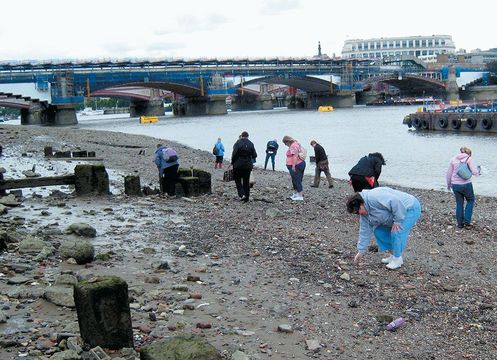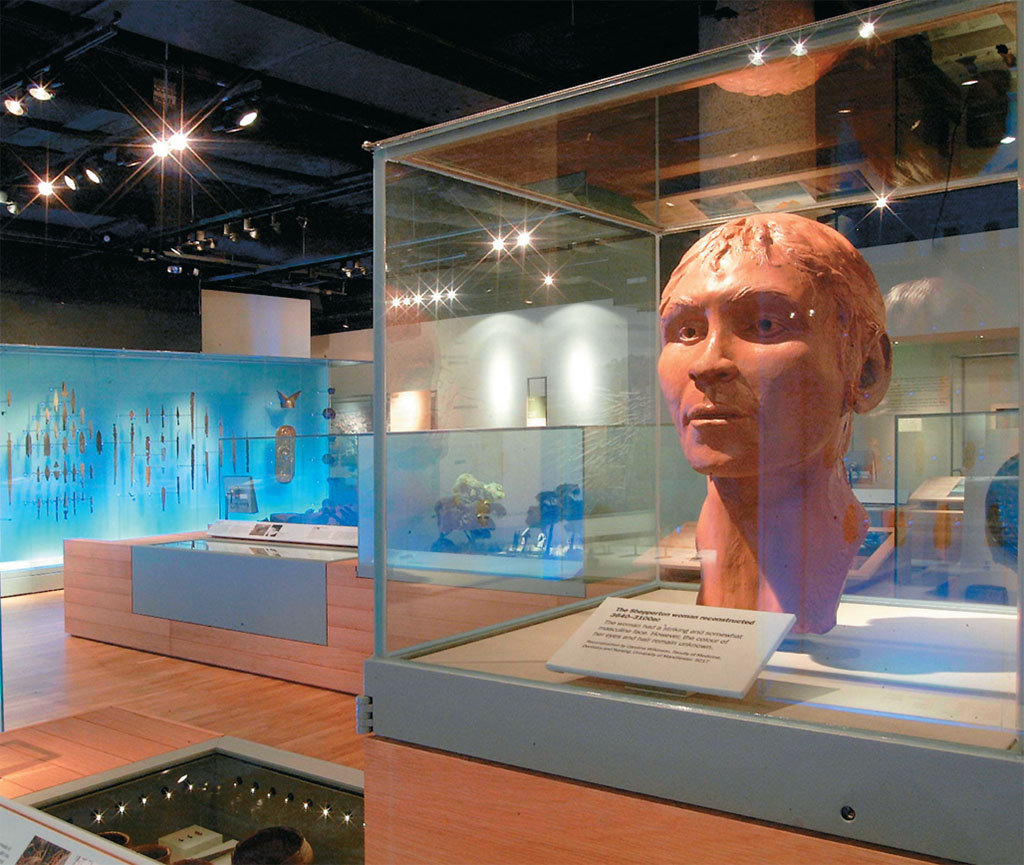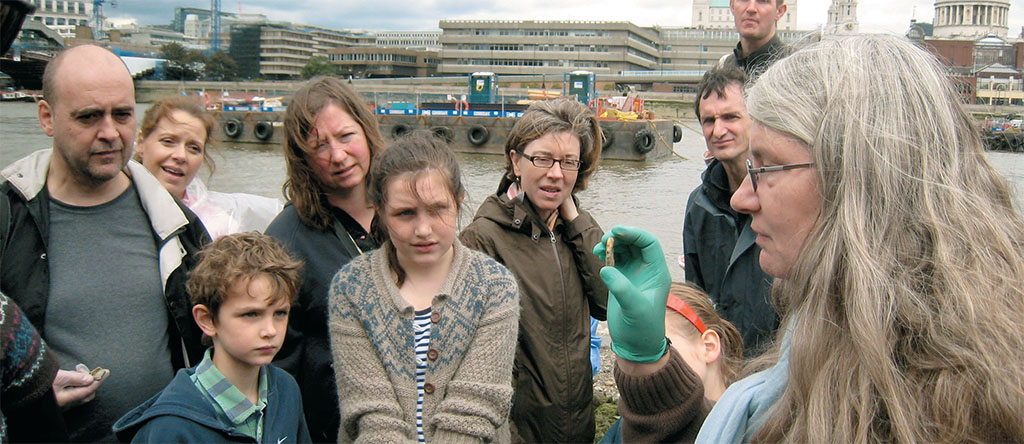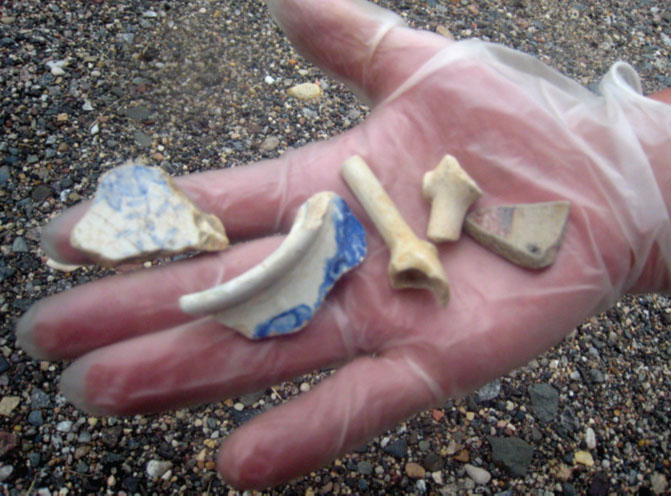
For 200 years, mudlarks scrounged a living in the tidal flats of the River Thames. Today, intertidal archaeology can be a fun London adventure.
For 200 years, mudlarks scrounged a living in the tidal flats of the River Thames. Today, intertidal archaeology can be a fun London adventure.
* Originally published in Jan 2012.
On a cool summer, Sunday, thirty or so of us grown-ups plus a few kids are gathered outside London’s Mansion House tube station. We are waiting for Fiona Haughey, an intertidal archaeologist, who will lead us to the Thames foreshore. A half-kilometer or so will be all ours to search. There, with luck, we will find anything from broken pipe stems, horses’ teeth, and unidentifiable bits of glass to Victorian jewelry, Roman coins, or Tudor buttons.
Haughey’s best find was a Bronze Age skull that had been trepanned—surgically opened (probably to let out evil spirits)—and then healed, indicating that the patient survived. It’s the oldest evidence of surgery in London and on display at the British Museum. But, she says, “I get very excited about a piece of Neolithic pottery that’s got a thumbprint on it. I’ve found hand axes that go back to the end of the last Ice Age, 10,000 years ago.” The numbers of participants in Haughey’s walks range from three to 100, and she conducts them in the rain, shine or blizzards.
Read more
We are going to an archaeological site, Haughey explains, and although she won’t confirm that it is the world’s largest, as some sources claim, it is certainly the largest in Britain. We are warned about the dangers of rat-borne illnesses, issued rubber gloves, and led to the river, learning along the way why Roman Londoninium was built between two hills on a tidal estuary and the names of all the bridges. We also learn that the Thames was extremely polluted until the 1950s when cleanup efforts were instituted, and now it’s the cleanest estuary in Europe.
“Now, we have 124 species of vertebrates and invertebrates living in the river, plus innumerable plants on the riverbed that you can’t see. It’s teeming with life. The Environmental Agency calls it the superhighway. Occasionally, you’ll see a cormorant dive down and come up with an eel, toss it up in the air with a bit of gung-ho, and swallow it like spaghetti. It’s all going on down there. My colleagues at the Environmental Agency often do a netting, where they haul a net around, and you see in there a huge range of species.”

© MUSEUM OF LONDON
Haughey explains that anyone can hunt for artifacts along the Thames. Many hobbyists do it regularly. “But if you do it, you should have a permit. English Heritage laws can specify which areas you can work in and which areas you can’t,” she says. “More importantly, they specify how much you can dig, if at all. For example, unless any of you can produce a Thames foreshore permit, you are not allowed to move any dirt at all, and by that I mean scuffing it with your foot or using a bit of nail to move things around. What you can do is pick things up, but you can’t move dirt.”
She stresses that there are unsafe areas in which to pursue mud-larking. This particular stretch, Bankside, is considered safe. Elsewhere, an illegal fraternity works regularly, digging huge holes, selling their finds—mainly coins—abroad, and they may be dangerous to approach.

The 2,000-year old Celtic bronze shield known as the Battersea Shield (left) was dredged from the River Thames in 1857. Treasures of the river belong to the Crown, and make their way to the Museum of London. JEAN PASCHKE
Haughey says, “If you find anything that is considered ‘treasure,’ I will take it to the Museum of London. I will put your name on it, but it will be up to the museum to decide what to do with it.”
“Don’t forget,” she adds, “anything that’s ‘treasure’ strictly belongs to Her Majesty, till proved otherwise,” and cheerful comments about paying for the royal wedding go around the group. The Museum of London has case after case of such finds, including pottery, weapons, buttons, and jewelry. The most splendid of these, the Battersea Shield, is displayed only in replica, with the original in the British Museum.
But mudlarking, as it is known, has a darker history. It was not always the province of happy hobbyists, but a necessity to keep families fed. In the 19th century, many of London’s poor made a living by scrounging items out of the mud. Men, young women (“tide-waitresses”), and children between the ages of 8 and 15 frequently visited the Thames foreshore or the River Fleet—once a stream running from Highgate to the Thames, now a sewer. They were “a picture of want and misery” in the words of a 19th-century writer. They searched for firewood, ropes that could be picked apart and made into tow, coal dropped from barges, iron, pewter, bones of drowned animals to be turned into fertilizer, broken glass, copper nails and bolts, rags or anything else that could be sold to a marine store keeper. With luck, they might earn sixpence a day.

Intertidal archaeologist Fiona Haughey leads folk on mudlarking expeditions that actually help tend the Thames foreshore. A clay pipe stem or bit of Victorian glass is your likely souvenir. JEAN PASCHKE
Mudlarks wore aprons with deep pockets or carried a bag on a leather shoulder strap, and dug through the silt with sticks, or felt for treasure with their feet. They weren’t above straying near stranded coal barges and relieving them of some of their cargo, or stripping copper from a moored barge. Sometimes they ventured into the sewers. They might find a purse dropped from a pleasure boat, a bit of precious jewelry, a piece of sterling tableware, or even as today, an antique relic.
Storms and floods brought joy to the mudlarks because buildings in Clerkenwell tended to get washed away, and a cache of furniture, housewares, birdcages, keys or toys was there to find. The owners might go out in boats to claim their belongings, but often the mudlarks beat them to it.
Most beachcombers find items that have washed ashore from the ocean, but this beach is different: “It all came down out of the city, or was originally here,” Haughey said. “Underneath all of this are prehistoric land surfaces.” It turns out that the area we are going to search was part of a boat repair yard that operated from the late 1700s to the early 1900s, so many pieces of unidentifiable metal or nails may surface.
We climb down the stairs to the shore, wading first through what Haughey insists is clean silt, but is, in fact, very slippery mud. Its low oxygen content helps preserve items. As we search, tiny things begin to appear among the stones and shells—pipe stems mainly because from the 1560s to the 1930s, tiny clay pipes were sold packed with tobacco and discarded after use.
None of us find anything museum-worthy. One woman has a piece of salt-glaze pottery from the 1600s, another, a pipe stem from the 1700s. A man finds the top of a red Victorian teapot. I find a bit of blue-flowered china, which Haughey said comes from a Victorian dressing table stand, some unidentifiable stoneware, and metal bits, and, of course, pipe stems. We are urged to take away only one or two pieces.
After an hour, the tide washes us all ashore. Haughey is off for a two-month dig in Turkey. She leaves us with a parting thought: “I want people to embrace their area and look after their foreshore. You don’t need high-powered archaeologists. You need someone who’s around who can do that. You actually need people to look after their foreshore. This is a very fine resource, and when it’s gone, it’s gone.”
For more information: www.walks.com
* Originally published in Jan 2012.





Comments